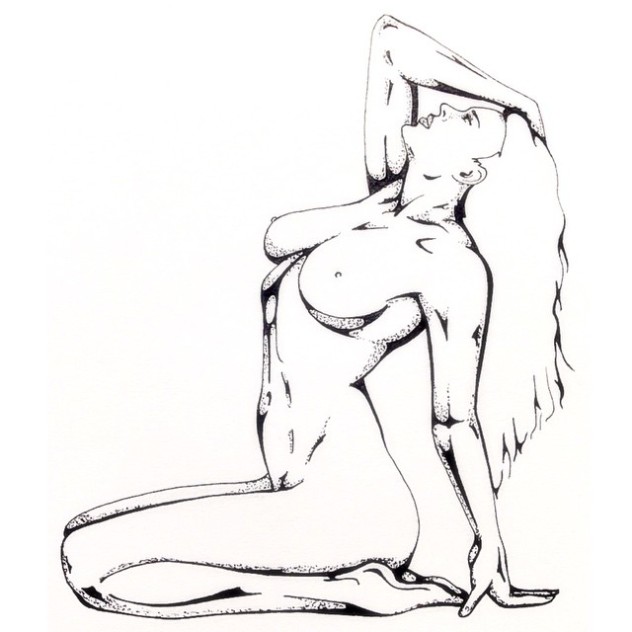Drawing for the Sake of It
 Drawing is a great visual-spatial exercise that allows the artist to save an idea on a surface on which it can develop to become a piece of art. Some people consider that first draft or what we call gesture drawing as an acceptable technique to be in itself a work of art. Either way, the process of drawing is helping the development of visual coordination, space management, composition, proportions, angles, volume, shapes, light, and shadows, and other elements. The outline separates the main figure from the background and from other objects to understand the position of each in relationship with the others. These skills can be transferred to other domains as interior design, architecture, fashion, web design, and graphic design.
Drawing is a great visual-spatial exercise that allows the artist to save an idea on a surface on which it can develop to become a piece of art. Some people consider that first draft or what we call gesture drawing as an acceptable technique to be in itself a work of art. Either way, the process of drawing is helping the development of visual coordination, space management, composition, proportions, angles, volume, shapes, light, and shadows, and other elements. The outline separates the main figure from the background and from other objects to understand the position of each in relationship with the others. These skills can be transferred to other domains as interior design, architecture, fashion, web design, and graphic design.
 Drawing also provides relaxation, and meditation benefits. It is a good exercise to just draw for a few minutes as part of a daily discipline. In those moments those drawings might not seem or considered a finished product, but the fact that one is getting involved in the creating process, one is building bridges neurologically and cognitively that could lead to complete works of art in the future. The original idea might change, evolve, develop, or remain the same. It could be just a foundation, or a detail element. One might not use that idea for a long time if you use it at all. The most important aspect is that moment. Is about drawing for the sake of it.
Drawing also provides relaxation, and meditation benefits. It is a good exercise to just draw for a few minutes as part of a daily discipline. In those moments those drawings might not seem or considered a finished product, but the fact that one is getting involved in the creating process, one is building bridges neurologically and cognitively that could lead to complete works of art in the future. The original idea might change, evolve, develop, or remain the same. It could be just a foundation, or a detail element. One might not use that idea for a long time if you use it at all. The most important aspect is that moment. Is about drawing for the sake of it.
Can’t draw? I think that is a lame excuse. Can’t draw what? Can’t draw how? Would you tell a 2-year-old kid that he or she lacks drawing skills? We are not 2-year-old but if they do it with freedom and not interested in the opinion of others, why not us? Why can’t we just take a pencil and scratch a paper? We create our own judgements and we allow other people to pass judgement feeding their ego and selfishness. Draw because it is fun, peaceful, entertaining, and relaxing. Draw because you enjoy it and not because others need to like it. They don’t have to.


Visual Intelligence
There are three classes of people:
those who see, those who see when they are shown, those who do not see.
Leonardo Da Vinci
Howard Gardner proposed in Frames of Mind: The Theory of Multiple Intelligences that intelligence as ‘one thing’ is too limiting to account to the broader range of human abilities and capabilities. He separates intelligence in nine modalities (I’m sure that the list will continue growing):
Look Up by Iván Tirado
It is possible that the first group of people coming to mind when one hears ‘visual intelligence’ is artists. Not only people who can draw, paint, sculpt, or design have visual intelligence. Visual intelligence is extended to sports. Court vision in basketball is important to shoot and pass the ball. The same applies in football, baseball, and boxing. Dancers too require that sense of space when they perform. Even today’s video games require visual intelligence with those virtual words that make me dizzy about five minutes into the game.
I do believe that artists have visual intelligence indeed. I also believe that artists share bodily-knestetic intelligence too in order to transfer their vision into a tangible creation. Bodily-knestetic intelligence is not only for sports and dance. I believe we can call it ‘technique’. Artists also share logical-mathematical intelligence. Moreover, artists are also existential or spiritual intelligent. Why it seems like I’m focusing in artists and visual intelligence? Well, I am an artist. I also stink at music and most sports. The fact is that my favorite aspect of visual intelligence because it is not about what we see with the eyes.
Blind people develop visual intelligence to make sense of their environment. Is that perception of space that goes beyond the world we see. Visual intelligence can inform the other intelligences allowing us to become aware of a different kind of world. We can close our eyes and see it. Our senses become consumed with it. This intelligence allows the development of problem-solving skills, capturing and interpreting information, and perceived the world we see with the naked eye and the world not seen. Leonardo Da Vinci called it ‘the reflective eye’. Leonardo believed that ‘the artist sees what others only catch a glimpse of‘.